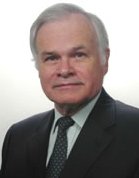Related Research Articles

Chobham armour is the informal name of a composite armour developed in the 1960s at the British tank research centre on Chobham Common, Surrey. The name has since become the common generic term for composite ceramic vehicle armour. Other names informally given to Chobham armour include Burlington and Dorchester. Special armour is a broader informal term referring to any armour arrangement comprising sandwich reactive plates, including Chobham armour.
In materials science, superplasticity is a state in which solid crystalline material is deformed well beyond its usual breaking point, usually over about 400% during tensile deformation. Such a state is usually achieved at high homologous temperature. Examples of superplastic materials are some fine-grained metals and ceramics. Other non-crystalline materials (amorphous) such as silica glass and polymers also deform similarly, but are not called superplastic, because they are not crystalline; rather, their deformation is often described as Newtonian fluid. Superplastically deformed material gets thinner in a very uniform manner, rather than forming a "neck" that leads to fracture. Also, the formation of microvoids, which is another cause of early fracture, is inhibited. Superplasticity must not be confused with superelasticity.

Sheffield Hallam University (SHU) is a public research university in Sheffield, South Yorkshire, England. The university is based on two sites; the City Campus is located in the city centre near Sheffield railway station, while the Collegiate Crescent Campus is about two miles away in the Broomhall Estate off Ecclesall Road in south-west Sheffield. A third campus at Brent Cross Town in the London Borough of Barnet is expected to open for the 2025-26 academic year.
A cermet is a composite material composed of ceramic and metal materials.
Dental restoration, dental fillings, or simply fillings are treatments used to restore the function, integrity, and morphology of missing tooth structure resulting from caries or external trauma as well as to the replacement of such structure supported by dental implants. They are of two broad types—direct and indirect—and are further classified by location and size. A root canal filling, for example, is a restorative technique used to fill the space where the dental pulp normally resides.

A saggar is a type of kiln furniture. It is a ceramic boxlike container used in the firing of pottery to enclose or protect ware being fired inside a kiln. The name may be a contraction of the word safeguard.

Ceramic engineering is the science and technology of creating objects from inorganic, non-metallic materials. This is done either by the action of heat, or at lower temperatures using precipitation reactions from high-purity chemical solutions. The term includes the purification of raw materials, the study and production of the chemical compounds concerned, their formation into components and the study of their structure, composition and properties.
Wilson Benesch is a British company that designs and manufactures hi-fi high-end audio equipment, like loudspeakers and turntables. Wilson Benesch was founded in 1989 in Sheffield, South Yorkshire, England. Today the company is regarded as an audio design companies in the United Kingdom. Wilson Benesch operates its entire design and manufacturing operation from Falcon House, an art-deco styled building in the North-West of the city and the original home of Batchelors, built in the 1930s.

Prof. Roger R. Naslain is French chemical and physical scientist. He has been a professor at the University of Bordeaux 1 since 1969.

Thomas Edward Allibone, CBE, FRS was an English physicist. His work included important research into particle physics, X-rays, high voltage equipment, and electron microscopes.

The American Ceramic Society (ACerS) is a nonprofit organization of professionals for the ceramics community, with a focus on scientific research, emerging technologies, and applications in which ceramic materials are an element. Since its inception, ACerS has been committed to driving innovation, facilitating the exchange of knowledge, and fostering collaborations within the ceramics community. It is located in Westerville, Ohio.
Ceramic armor is armor used by armored vehicles and in personal armor to resist projectile penetration through its high hardness and compressive strength. In its most basic form, it consists of two primary components: A ceramic layer on the outer surface, called the "strike face," backed up by a ductile fiber reinforced plastic composite or metal layer. The role of the ceramic is to (1) fracture the projectile or deform the projectile nose upon impact, (2) erode and slow down the projectile remnant as it penetrates the shattered ceramic layer, and (3) distribute the impact load over a larger area, which can be absorbed by ductile polymer or metallic backings. Ceramics are often used where light weight is important, as they weigh less than metal alloys for a given degree of resistance. The most common materials are alumina, boron carbide, and, to a lesser extent, silicon carbide.
Olusegun O. Adewoye (1947–2015) was the director general and chief executive of the National Agency for Science and Engineering Infrastructure (NASENI), Abuja, Nigeria.
The A. A. Griffith Medal and Prize was awarded annually from 1965 to 2021 by the Institute of Materials, Minerals and Mining in commemoration of Alan Arnold Griffith.
Sheffield Olympic Legacy Park, in Sheffield, South Yorkshire, England, is a sports and recreation hub for health and wellbeing collaborative research and learning.
Atul Harish Chokshi is an Indian materials scientist, metallurgical engineer and a professor at the Department of Materials Engineering of the Indian Institute of Science. He is known for his studies on high temperature deformation and failure of ceramic materials and is an elected fellow of all the three major Indian science academies viz. the National Academy of Sciences, India, Indian Academy of Sciences, and Indian National Science Academy as well as the Indian National Academy of Engineering. The Council of Scientific and Industrial Research, the apex agency of the Government of India for scientific research, awarded him the Shanti Swarup Bhatnagar Prize for Science and Technology, one of the highest Indian science awards for his contributions to Engineering Sciences in 2003.
Cóilín Ó Dubhghaill is an Irish artist and academic, crafting as a silversmith and also in copper and Japanese-inspired copper alloys, gold and other metals. He lived in Japan and studied Japanese metal crafts for seven years in the national arts university. His art is held in a range of national and other museums and galleries, and has been widely shown. His research work bridges art and materials science, and he is co-inventor of a new hybrid metal, mikana.
Niiro, also known as niiro-eki (煮色液), niiro-chakushoku (煮色着色), nikomi-chakushoku (煮込み着色) or niage (煮上げ) is an historically Japanese patination process, responsible for the colouration of copper and certain of its alloys, resulting in the irogane class of craft metals, including shakudo, shibuichi and kuromido. It is now practiced in a number of countries, primarily for the making of jewellery and decorative sword fittings, but also for material for hollowware and sculpture. Importantly, the same process operates differently on different metals so that a piece with multiple components can be treated in one patination session, developing a range of colours.
Allan Matthews (1952) is professor of surface engineering and tribology at the University of Manchester and director of the Digitalised Surfaces Manufacturing Network.
Keith John Bowman is a materials scientist and dean of the University of Maryland, Baltimore County College of Engineering and Information Technology, working to advance research benefiting society and elevating student educational success. He is a Fellow of The American Ceramic Society. Bowman has worked extensively to advance diversity, equity, and inclusion across engineering disciplines and the science, technology, engineering, and math (STEM) pipeline. He is a member of 500 Queer Scientists. He is internationally recognized for his research on the property anisotropy and preferred orientation in ceramics and ceramic composites.
References
- 1 2 3 4 5 6 "Hywel Jones - Sheffield Hallam University". www.shu.ac.uk.
- 1 2 "Dr Hywel Jones - Media - Sheffield Hallam University". www4.shu.ac.uk.
- ↑ Companies House - Appointments - Alan Hywel Jones, checked 26 March 2018
- ↑ I'n a scientist - Profile - HywelJones
- ↑ "Dr Hywel Jones - Materials and Engineering Research Institute - Sheffield Hallam University". www4.shu.ac.uk.
- ↑ "Success 1400 times over". www.thestar.co.uk.
- ↑ "Previous Venture Prize Winners". Armourers' Hall.
- ↑ "Sheffield Hallam University - Relationship Science". relationshipscience.com.
- ↑ Derbyshire, David (19 February 2018). "Scientists take a shine to 'stainless' silver" – via www.telegraph.co.uk.
- 1 2 Creative, Prototype. "Mikana". www.mikana.co.uk.